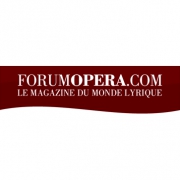D’une grande clarté, vive et rythmée, non dépourvue d’une salutaire pointe d’humour, la direction d’acteur suit les méandres jaloux et amoureux des protagonistes
Semele, Handel
Set design
Oliver Mears offers a bold reinterpretation of Handel's opera, seeking to strip it of its traditional mythological setting and project it into a contemporary universe, exploring the political and satirical aspects of the work. Through his staging, he tackles highly topical subjects such as power, desire, abuse and class inequalities, emphasising the relationship of domination between Jupiter, a figure of patriarchal power, and Semele, an ambitious but vulnerable young woman. Semele is presented not only as a mythological lover, but as a fragile figure in search of recognition and a new social status. Oliver Mears' staging is also inspired by cinematic references: an atmosphere of uncanny strangeness borrowed from the horror films of the era and a touch of surreal humour and darkness à la Luis Buñuel.
Scenography and costumes
Annemarie Woods' stage design evokes a luxurious and opulent palace from the 1950s and 1960s, with lighting (by Fabiana Piccioli) accentuating the dramatic tension. At the centre of the room, an imposing black fireplace becomes a symbol of the destructive fire to come, serving as both a domestic hearth and a sacrificial altar. As the drama unfolds, bay windows open onto a starry sky, highlighting the contrast between everyday life and the celestial, but also between power, appearances and the threat of divine forces. Elements such as funeral urns and ashes are used to introduce death from the very beginning of the opera.
The elegant and understated costumes anchor the characters in a contemporary era, between retro glamour and dramatic realism. The employees, mere humans, wear the company uniform, while the owners-deities wear rich costumes. Semele, often dressed in light, colourful fabrics, embodies a fragile and exposed sensuality. Jupiter, an all-powerful patriarchal figure, oscillates between ceremonial costume and nakedness.
Dans la presse


Une transposition habile de la mythologie antique dans les années 1960

L’astucieuse production d’Oliver Mears est un compromis plein d’esprit qui fonctionne parfaitement

Oliver Mears habille en permanence la scène d’un jeu d’acteurs hyper réglé, dans un décor et des costumes bien usités et des lumières seyantes
Documentation disponible
- Programme : PDF
- Video interview of Oliver Mears
- Vidéos : Trailer, interviews, excerpts
(c) photos : Vincent Pontet






